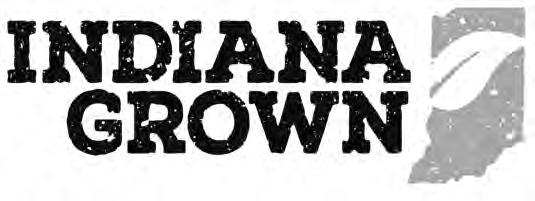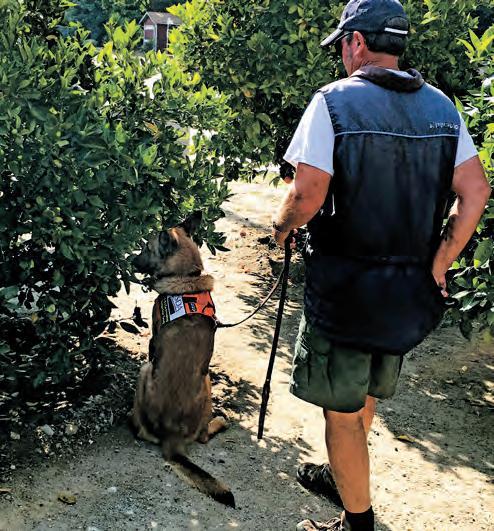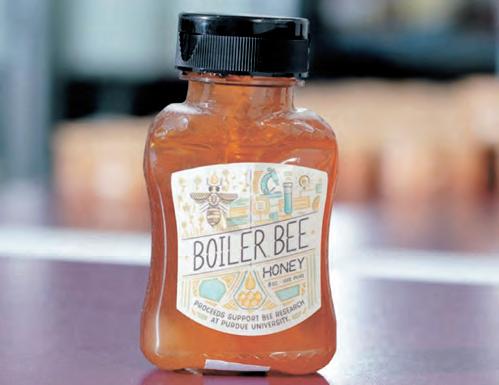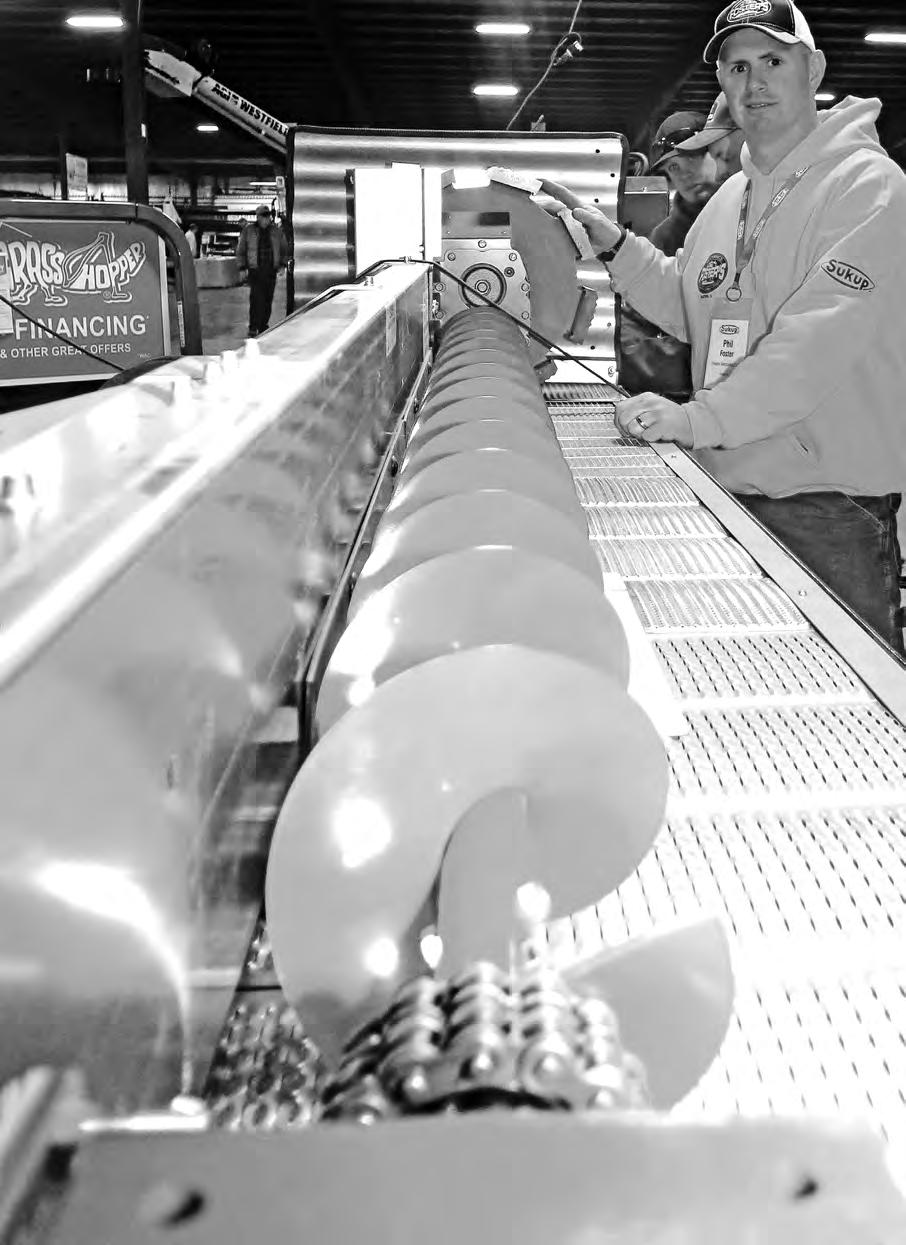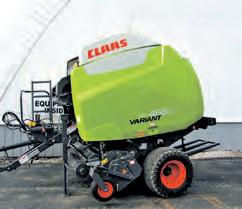
11 minute read
Bear Wallow Distillery
Beef export value again tops $8B
DENVER — U.S. pork exports posted new volume and value records in 2019, reaching nearly $7 billion, according to data re leased by the U.S. Department of Agriculture and compiled by the U.S. Meat Export Federation.
Exports of U.S. beef were below the previous year’s record levels, while lamb export volume was the second largest on record. Pork exports soared to 282,145 metric tons in December, up 34% year-over-year and surpassing the previous high, set in November 2019, by 9%. Export value was $760 million, up a remarkable 44% from a year ago and break ing the previous record, also from November 2019, by 7%.
New research is for the BRD Drug treatment for respiratory disease
MANHATTAN, Kan. — A new study from Kansas State University on the treatment of non-responding cases of bo vine respiratory disease, known as BRD, conducted by Hans Coetzee and his collaborators from Iowa State University, sheds light on the relationship between drug treatments and the emergence of antimicrobial resistance.
The study, “Association between antimicrobial drug class for treatment and retreatment of bovine respiratory disease and frequency of resistant BRD pathogen isolation from vet erinary diagnostic laboratory samples,” was published in the December 2019 issue of the jour nal PLOS ONE.
“Bovine respiratory disease is one of the most important diseases facing beef cattle pro ducers in the United States with economic losses estimated to approach $1 billion a year,” Coetzee said. “Antibiotics are critical to minimize losses asso ciated with BRD caused by bacterial infections.”
Antibiotics that are used to treat BRD are broadly classified into two groups, namely those that prevent growth of the bac teria, that is bacteriostatic, and those that kill the organism, that is bactericidal.
Although 90% of BRD relapses are reported to receive retreatment with a different class of antimicrobial, the impact of an tibiotic selection — bactericidal or bacteriostatic — on disease outcomes and the emergence of antimicrobial resistance has not been investigated, according to Coetzee.
The focus of the study is determining the association between antimicrobial class selection for treatment and retreatment of BRD relapses and antimicrobial susceptibility of Mannheimia haemolytica, Pasteurella multo cida and Histophilus somni.
Pathogens were isolated from samples submitted to the ISU Veterinary Diagnostic Laboratory from January 2013 to December 2015. A total of 781 isolates with corresponding an imal case histories, including treatment protocols, were in cluded in the analysis.
“Our overall interpretation of the data suggests that there is direct association between the number of treatments to which an animal was exposed and the emergence of anti biotic resistance in samples submitted to a veterinary diag nostic laboratory for analysis,” Coetzee said.
“In addition, these exploratory data suggest that BRD treatment protocols involving first-line treatment with a bacteriostatic antibiotic followed by sec ond-line treatment with a bactericidal antibiotic may increase the probability of isolating BRD bacteria that are resistant to an tibiotics.”
While this observation suggests that consideration should be given to the mechanism of action of the antibiotic when selecting drugs for retreatment of non-responding cases of BRD, Coetzee said further re search is needed to determine the clinical relevance of this finding in livestock production systems.
Coetzee is a professor and head of the anatomy and physiology department at the College of Veterinary Medicine. He has published 160 peer-reviewed sci entific papers and has received more than $10 million in re search funding. These results pushed 2019 exports 10% above the previous year in volume, at 2.67 million mt, and 9% higher in value, at $6.95 billion, breaking previous records for both volume, at 2.45 million mt in 2017, and value, at $6.65 billion in 2014.
Pork export value per head slaughtered was $66.70 in December, nearly one-third higher than a year ago and the highest monthly average since 2014. For 2019, per-head value averaged $53.51, up 4% year-over-year.
The percentage of pork production exported also set new records in December, as exports accounted for 32.1% of total pork production and 29.3% for muscle cuts only, up substantially from a year ago, at 26.1% and 23.6%, respectively.
In 2019, exports accounted for 26.9% of total pork production, up from 25.7% and the highest since 2012. For muscle cuts only, the ratio was 23.6%, up from 22.5% in 2018.
“Despite retaliatory duties and the other barriers U.S. pork faces in China, exports to the China/ Hong Kong region closed 2019 with tremendous momentum,” said Dan Halstrom, USMEF President and CEO.
“We look forward to continued success in 2020, especially if U.S.-China trade relations continue to trend in a positive direction. The coronavirus situation is certainly concerning and disruptive, but it hasn’t dampened our enthusiasm for the potential this market holds for U.S. red meat.”
December beef exports totaled 111,315 mt, down 1% from a year ago, valued at $682 million, down 3%. Exports in 2019
IPPA FARM FAMILY OF THE YEAR
totaled 1.32 million mt, 2.5% below the previous year’s record volume. After increasing by more than $1 billion in 2018, beef export value eased by 3% to $8.1 billion.
Beef export value per head of fed slaughter was $321.21 in December, down 9% from a year ago. The 2019 average was $309.75, down 4%. December exports accounted for 14.3% of total beef production and 11.6% for muscle cuts only, down from 15.5% and 12.6%, respectively, a year ago.
Exports in 2019 accounted for 14.1% of total beef production and 11.4% for muscle cuts, down from the previous year’s record-high percentages, at 14.6% and 12.1%, respectively.
“It was gratifying to see beef exports to Japan perform so well in December, given that the first tariff rate cut was pending and set to take effect Jan. 1,” Halstrom said.
“Buyers in Japan have been waiting a very long time for tariff relief and have already responded enthusiastically. We look forward to solid growth in 2020 and beyond.”
December exports of U.S. lamb were 1,225 mt, up 9% from a year ago, while value jumped 24% to $2.36 million. For 2019, lamb export volume increased 22% from a year ago to 15,732 mt, valued at $26.1 million, up 12%.
Led by strong demand in Mexico, export volume was the second highest on record behind 2011 and export value was the highest since 2014. In addition to Mexico, strong growth markets included Trinidad and Tobago, Panama, Guatemala and the Philippines.
We Care progress
PROVIDED PHOTO The Cowser family farming operation includes a breed to wean pig farm, a cow/calf herd and a corn and soybean farming operation. The members of the 2020 Illinois Pork Producers Association Farm Family of the Year are Charlotte and Steve Cowser (front row from left), Cheryl Cowser-Walsh, Andy and Carol Cowser; Marc Cowser (top row), Darin Cowser and Alan Cowser.
Raising pigs since 1932
Cowser pork operation is a farm foundation
By Jeannine Otto AGRINEWS PUBLICATIONS
BRADFORD, Ill. — The Cowser family farming operation is many things — and many people — but underpinning all of the farm operations is family. The Cowser family is the 2020 Illinois Pork Producer Association Farm Family of the Year.
“We all want the farm to be successful,” said Steve Cowser of the farming operation that his grandfather, Delbert Cowser, started in the 1930s near Laura.
Today, Steve and his three brothers, Marc, Andy and Darin, and Andy’s two children, Alan Cowser and Cheryl Cowser-Walsh, comprise the main part of the Cowser family farm.
Steve Cowser leads the pork production part of the farm and oversees the farm operation’s finances.
After almost 50 years in the pig business, some might be thinking about retiring, but Cowser is not among them.
“I am having too much fun,” he said.
Cowser works in the barns and is focused on ways to improve the pork operation and grow his own knowledge.
“I learn something new every day I am in the barns. That’s one of the things I like about this business,” he said.
IN THE BEGINNING
The family always has raised pigs, starting with Delbert Cowser’s swine herd in 1932. In 1998, they purchased a breed-to-wean barn and 1,200 sows.
They increased that herd, and they wean about 1,100 pigs weekly as an independent breed-to-wean farm. The Cowsers partner with Land O’Lakes as the buyer of their weaned pigs.
Constant improvement is a constant theme for all parts of the Cowser farming operation. On the pork side, the breed-towean model is a perfect fit.
“It allows us to do one thing, focus on one area of production, and hopefully become better at that,” Steve Cowser said. The biggest challenge on the pork production side is labor. The breed-to-wean operation employs nine people as a full staff.
“Half of our crew are longterm employees, seasoned and experienced, and there are two or three who are newer employees and some of those don’t stay very long,” Cowser said.
ANIMAL HEALTH
Biosecurity is a priority on the farm.
“In 2015, we revamped our entrance, so the only way to get in and out is through the showers,” Cheryl Cowser said. Everyone entering the sow barn is required to shower upon entering and shower on leaving.
All supplies, from bagged feed products to medicines to equipment parts, entering the building have to pass through the “fume room,” a fumigation room.
The Cowsers transport their own pigs and feed, reducing outside traffic into the sow farm. The farm has a truck wash to clean and sanitize the farm’s trucks before they enter the property.
While Steve Cowser said he enjoys working in the barns, with farrowing being his favorite job, working with the farm’s finances is another task he finds both challenging and rewarding.
“We have to make enough profit to provide a living for all six people involved in the farm. It’s a challenge nowadays,” he said.
That the farm known as Cowser Inc. is a family farm is a message that Cheryl CowserWalsh emphasizes in her work with Ag in the Classroom programs in Bureau and Peoria counties.
“One of the big misconceptions is when you see a hog
Meet the Cowsers Six families make up Cowser Inc., the family crop and livestock farm in rural Bradford, Illinois. They are: n Steve Cowser and his wife, Charlotte, live in Bradford, Illinois. They are the parents of Mike, who died in an accident at age 14, and Shelli (Jim) and the grandparents of Kelsie. n Andy Cowser and his wife, Carol, live in Laura, Illinois. They are the parents of Cheryl, Alan (Katie), Aaron (Kelly) and Adam (Liz) and the grandparents of Alyvia, Reagan, Rylie, Kinsley, Colson, Brenner, Kendall, Brooks, Briggs and Allish. n Marc Cowser and his wife, Carol, live in Tiskilwa, Illinois. They are the parents of Tim, Scott (Lori) and Renee (Jonathan) and the grandparents of Jhett, Solomon, Josiah and Adeline. n Darin Cowser and his wife, Susan, live in Peoria, Illinois. Darin has four children, Meghan, Seth, Zac and Tessa. n Cheryl Cowser-Walsh lives in Princeville, Illinois, and has two daughters, Reagan and Rylie. n Alan Cowser and his wife, Katie, live in Princeville, Illinois. They are the parents of Alyvia, Colson and Kendall.
barn and people say, ‘Well, it’s not family owned.’ That’s the part that I personally struggle with. The name of the company that we market our livestock through is a corporation. That’s just a business model. It’s not owned by corporate people. It’s still owned by us. Some people just assume because of the ‘Inc.’ that it’s owned by a big corporation, and it’s not — it’s a family farm. It’s our family’s farm,” she said.
New sustainability study released by pork industry
DES MOINES, Iowa — The pork industry released its new sustainability report, Commit and Improve: Pig Farmers’ Approach to Sustainability, and updated website, porkcares.org. The report and website share firsthand accounts and data supporting pig farmers’ progress toward sustainability through the We Care ethical principles.
“As pig farmers, we are com mitted to producing safe food, protecting the environment and caring for our pigs by following the six We Care ethical principles,” said David Newman, president of the National Pork Board and a pig farmer representing Arkansas.
“These new resources were developed to share relevant information and metrics and to lay a foundation for continuous improvement in the area of sustainability.”
The new report demon strates the progress pig farmers have made toward the We Care ethical principles of: Food Safety, Animal Well-Being, the Environment, Public Health, Our People and Communities. Data for the report was gath ered from governmental agencies, the pork industry’s life-cycle assessment and pig farmers from across the country.
Highlights that demonstrate the pork industry’s commitment to the We Care principles include: n According to the Environmental Protection Agency, pork production contributes just 0.46% of U.S. greenhouse gas emissions to the atmosphere. n More than 71,000 individuals are Pork Quality Assurance Plus certified, representing roughly 85% of U.S. pork production. n The pork value chain has come together to develop and use the Common Swine Industry Audit, which is certified by the Professional Animal Auditor Certification Organization. n The most recent life-cycle assessment, A Retrospective of U.S. Pork Production, shows a significant reduction in the use of natural resources during the past 55 years. Per pound of pork produced, U.S. pork producers have reduced land use by 76%, water use by 25%, energy use by 7% and their carbon footprint by more than 7%. n More than 94% of pig farms keep detailed medical and treat ment records, which shows pig farmers’ commitment to respon sible antibiotic use. n In 2018, pig farmers donated 3.2 million servings of food, volunteered more than 54,000 hours and donated more than $5.5 million to local charities.
“The findings in the sustain ability report and on porkcares. org not only illustrate our commitment to ethical and sustainable practices, but also show our commitment to transparency as an industry,” said Brett Kaysen, assistant vice president of sustainability for the Pork Checkoff.
“We look forward to sharing this powerful story and our continued progress with the global pork supply chain and with consumers around the world.”
The report can be downloaded at porkcares.org.

